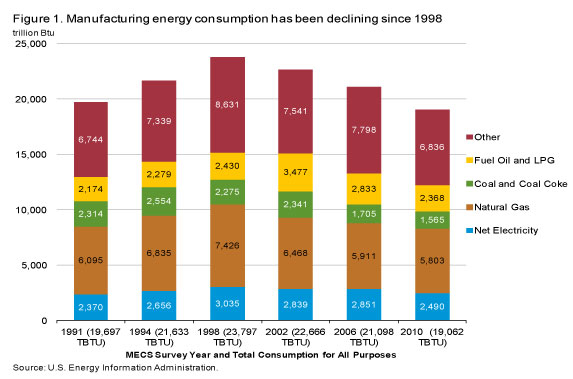Plastics Business
Energy consumption has long been a target for sustainability efforts at plastic processing facilities, as well as from the companies that supply equipment to those in the industry. A recent report from the US Energy Information Administration indicates those efforts are making an impact.
Total energy consumption in the manufacturing sector decreased by 17 percent from 2002 to 2010, according to preliminary data collected in the 2010 Manufacturing Energy Consumption Survey. It also indicated gross output decreased by only three percent over the same period, pointing to a significant decline in the amount of energy used per unit of gross manufacturing output.
The manufacturing sector used over 14 quadrillion Btu of energy as a fuel in 2010, the report said, which is a decrease of 13 percent from the MECS 2002 level. The overall decrease in energy consumption from 2006 to 2010 mirrors the slowdown in manufacturing production during the same period, as measured by the Federal Reserve Board and Bureau of Economic Analysis in separate annual manufacturing output indexes.
Helping plastics processors cut energy use has been an objective of The Conair Group for many years, said Ray Kelly, vice president-engineering. The Cranberry Township, PA-based auxiliary equipment supplier has made a commitment to economic and ecological sustainability by developing equipment that helps plastics processors reduce energy consumption, make better use of raw materials, reclaim scrap and improve process yield.
While noting not all auxiliaries are power hungry, Kelly said some processes, like resin drying, material handling and conveying, heat transfer systems and granulation for instance, can be very energy-intensive. Several Conair developments address these concerns, including dryers that automatically adjust airflow and temperature to match process demand; energy-efficient granulators that incorporate solid-state motor controllers to ramp up speeds in a sort of “soft start” that reduces inrush current up to 70 percent and cut energy use by up to 50 percent; variable-frequency motors on chiller pumps and cooling-tower fans to match output more closely to load; and idle-mode valves and vacuum-relief valves on central material-conveying systems to eliminate energy-intensive start/stop cycling of pump motors.
“Besides building equipment that is inherently energy efficient, Conair also is advising processors on ways to optimize equipment operation and maintenance to reduce power consumption,” Kelly said. “Keeping granulator blades sharp, for instance, reduces the amount of energy consumed in grinding scrap. Making sure conveying lines and vacuum pumps are properly sized and installed also can help.”
Although overall manufacturing output declined by three percent between 2002 and 2010, some manufacturing industries grew over the period, according to the MECS report. The reduction in employment and increase in gross output signals an increase in labor productivity during this same period.
“Energy savings have not come from just a few major innovations,” Kelly said, “but from literally dozens of changes both large and small that, together are cutting costs for processors every day.”
For more information, visit www.eia.gov and www.conairgroup.com.





